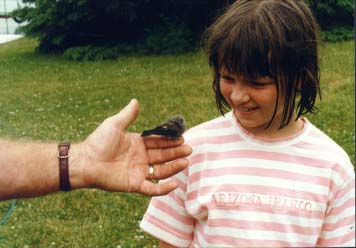

"Mommy, Mommy, come quick, I found a baby bird and it needs help. HURRY!!!" was my daughter's urgent cry. She led me down to the beach and at the base of the slide about three inches from shore was a shivering ball of feathers, seemingly just barely alive. Her cries brought the rest of the relation and my uncle was the one who told me to pick it up with my hands. I was brave and did, but immediately handed the bird to him. He cradled it in his muscular hands, providing a warm place for the bird's feathers to dry.
Evidently, the young bird must have gotten too frisky and fallen or flown out of its nest and landed near the lake. It had just rained, so that explained its soaked body. We had never seen a baby bird with yellow tinged back and tail feathers. I thought it was a goldfinch, but realized that the immature birds don't have the bright yellow color.
My daughter wanted to keep the bird, we all knew it wouldn't survive without its mother to feed it. After several attempts at feeding it some live bugs, we decided that my uncle needed to chew up the insects and feed it to the bird. He decided he didn't want to get that involved.
In a stroke of genius, my nature minded uncle placed a stick out the hole of one of the bluebird houses, which is near the shoreline where the bird was found. He carefully placed the bird on the branch and then we all waited to see what would happen. In less than three minutes, the mother bird flew to the baby's side and popped some delicious insects into its mouth. Then off it flew to catch some more. This scenario was repeated a few times, and the entire time the bird sat in the same spot on the branch (as if on a "time out," as a child who has misbehaved.)
In one final scene, the mom flew to the branch, chirped a few lines, then the baby bird took flight and landed in our large evergreen. The mom followed. All that I could hear for the next several minutes was high pitched chirping, back and forth between the birds. I was imagining that the baby was trying to explain what he had been doing leaving the nest, and the mom was scolding him to beat the band. We found it quite amazing that the mother bird had probably been watching us the entire time we were holding and trying to figure out what to do with her baby. Score one for human beings helping, instead of hurting, nature.
Our next puzzle was to try to figure out what kind of bird we had rescued. After pouring over several bird books, we determined that it was an American Redstart.
As part of the wood warbler family, the American Redstart is common in deciduous forests which are near water. Its identifying mark is the patches of yellow (immature and female) and orange (male) in its wing and fan tail.
The American Redstart feeds on insects, flea beetles, leaf beetles, round- headed wood borers, caterpillars of brown-tail and gypsy moths, canker- worms, moths, treehoppers, plant lice, spiders, wasps, and other insects, as well as some fruits and seeds. It was no wonder my uncle didn't want to chew up some food for the little bird to eat.
My daughter was disappointed that we couldn't keep the bird for a pet. I believe all the adults were thrilled that the mother found the baby bird and appeared to be able to take care of it. As I told my daughter, maybe now that we know what the American Redstart looks like, maybe we'll see more of them. And if one of them tips it's wing toward my daughter, we'll know it's the one she found while scrutinizing a view from the lake.
Information for this column was taken from:
A Guide to Field Identification Birds of North America by Robbins, Bruun, and Zim.
The Audubon Society Encyclopedia of North American Birds by John Terres.